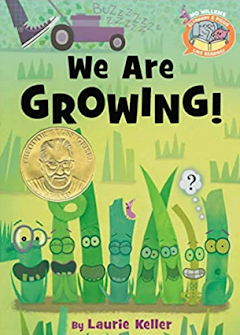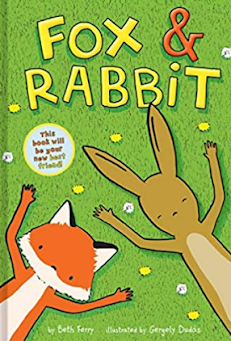Beginning and Transitional Books
For this week, we are looking at beginning and transitional books for children. These are books that help children to read more independently. As Kathleen Horning points out in the book From Cover to Cover: Evaluating and Reading Children’s Books, almost paradoxically, beginning books for children are written at a simpler reading level than picture books because they are meant to be read because they are meant to be read by the children instead of to the children. Thus, finding books that engage children independently is the next important step for encouraging reading adventures.
We are Growing!
Introduced by the beloved Elephant and Piggie duo from Mo
Willems, We are Growing! Tells the tale of blades of grass that are
growing and changing. As they grow, they each discover something about
themselves that makes them special and unique, except for one, Walt. When the
grasses are cut by the lawn mower, Walt discovers his talent, while the other grasses
learn that they will grow again.
This book shows characteristics that typify a level 1 beginning
book. The typeface is large and in an . While Level 1 is 17-20 point font, much
of the font is even larger, with many of the words being in all capital letters,
often the first version of letters children recognize. Lines are short, with
fewer than 3-4 words per line, often only a single word on a line as part of a
speech bubble. Most words are sight words but there are exceptions for the superlatives.
While children may not be able to initial know the word “silliest,” for example,
the repetition of the words and the word evolution from “silly” to “silliest”
along with the illustrations provide context clues. There are fewer than 7
lines of text per page, even when the grasses get excited and all are talking.
Keller, Laurie, and Willems, Mo. 2016. We Are Growing!
Illustrated edition. New York: Hyperion Books for Children. ISBN: 978-1-4847-2635-8
A Pig, a Fox, and a Box
A Pig, a Fox, and a Box is
a Theodore Suess Geisel award honor that tells the tale of a fox who decides to
use his box to trick his friend Pig into thinking that he needs help. This does
not work as planned for Fox and the tricks go awry in each of the three chapters.
With bright graphics, the book draws young beginning readers into the
misadventures of Fox as he seeks to outwit Pig.
While advertised as a Level 2 reader, this book is an early level
2 or late level 1. Sentences are slightly more complex with more sight words, but
multisyllabic words are rare. The book has a rhyming scheme coupled with the
illustrations to help young readers be able to guess at any words that are
unfamiliar to them. There are on average under 5 words per line and there are
2-7 lines per page, as opposed to the up to 14 that are part of the level 2
reader features. With a graphic novel type format, the illustrations cover most
of the space of the page. The quirky tale easily draws the reader along to encourage
and entertain.
Fenske, Jonathan. 2021. A Pig, a Fox, and a Box.
Random House Books for Young Readers. ISBN: 978-0-593-43264-8
A transitional reader book with many short chapters, this installment
of the Alvin Ho series focuses on the fears and adventures of Alvin for
an upcoming camping trip with his father. Alvin is a child afraid of nearly all
things, especially related to camping, and he seeks help and tips from anyone
near to him that can help him survive the trip, including his uncle with extra
tricks and his brother with his dad’s credit card.
This Alvin Ho matches many of the transitional reader
characteristics as an early chapter book. The typeface was fairly large.
However, it often pushed the upper limits how many words per line and lines per
page. Sentences were full length and not broken into shorter lines. The book is
written from the narrative perspective of Alvin Ho, so the sentences were often
short or even broken down into lists, making them easier to read and allow for
more white space around the text. Illustrations are scattered throughout the
text, breaking it up, but are not the dominant feature of pages. Instead, they show
up every couple pages. Generally, the vocabulary is fairly simple, except for
comedic effect, such as when Alvin states that he is afraid of “Long words (especially
“hippopotomonstrosesquipedaliophobia,” which means the fear of long words).” The
18 chapters are short and episodic, with stories and adventures all their own
but building towards Alvin’s camping adventure. Sentences are generally simple
but can have multiple clauses. Overall, this book is more towards the end of
the transitional reader mark but compelling enough to pull the readers though.
Look, Lenore. 2009. Alvin Ho: Allergic to Camping, Hiking, and Other Natural Disasters. Reprint edition. New York: Schwartz & Wade.







Comments
Post a Comment